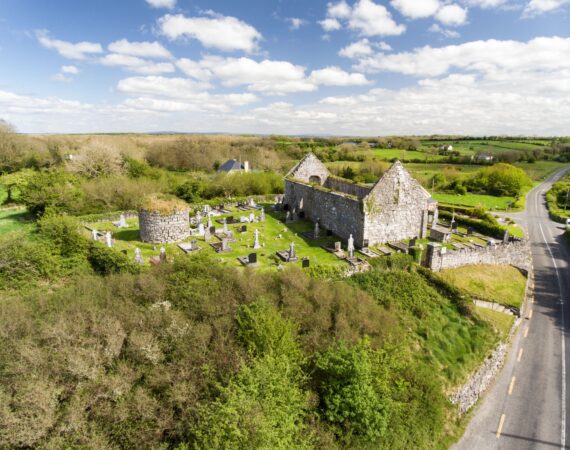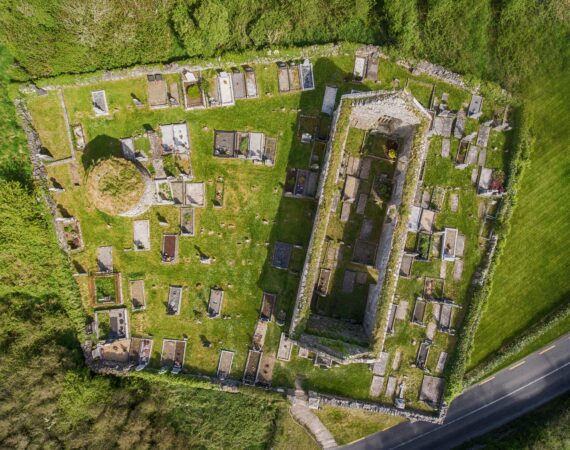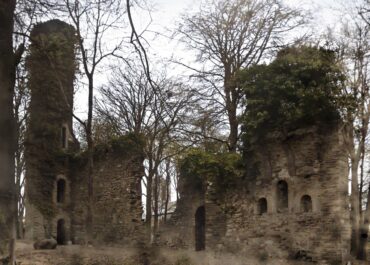Round tower, Killinaboy, Co. Clare
A stubby round tower and medieval church in County Clare hide surprising treasures, including a mysterious sheela-na-gig and a rare Cross of Lorraine.
Round tower, Killinaboy, Co. Clare
Sitting on the edge of a windswept plateau near Corofin in County Clare, Kilnaboy church and its truncated round tower have watched over the Fergus River valley for nearly a thousand years. While the round tower might disappoint at first glance; it’s just a 13-foot stub of its former self, the site rewards closer inspection with medieval mysteries and centuries of local history carved in stone.
The Round Tower
Let’s address the elephant in the graveyard first: Kilnaboy’s round tower is essentially a stone stump. Standing just 3.6 to 4 meters high (depending on which side you measure), this limestone cylinder is all that remains of what was once a typical Irish round tower. Built from roughly coursed limestone blocks with tight joints, it measures about 52 feet in circumference.
Local tradition blames Cromwell’s cannons for the damage to the tower’s southwest face, and given the Parliamentary forces’ documented presence in the area in 1651, this isn’t entirely implausible. The tower’s doorway has vanished, though a suspiciously round-tower-like doorway built into the church’s northeast corner might be the missing piece.
The Church
The church itself tells a more complete story. The oblong building measures 63 feet by 20 feet internally and shows evidence of multiple building phases. While much of what you see today dates from the 16th century or later (including repairs from 1715), the western gable and parts of the side walls preserve older medieval work.
The most intriguing feature lurks above the south doorway – a weathered but unmistakable sheela-na-gig, one of those enigmatic female figures that appear on Irish churches and continue to puzzle historians. The church also sports an unusual Cross of Lorraine built into its west gable, a rare feature in Irish ecclesiastical architecture.
Historical Connections
The site’s name, Kilnaboy (Cill Iníne Baoith in Irish), means “Church of Baoith’s Daughter.” This anonymous saint, whose feast day was December 29th, was powerful enough in local memory that her church’s desecration in 1573 supposedly led to divine retribution – the plunderers met a bloody end at the Battle of Balanchip Hill.
The church appears in taxation records from 1302-1306 and remained a focal point for both spiritual and military activities. In 1599, Hugh Roe O’Donnell used it as a rallying point during his raids into Thomond. The church continued serving the community until Corofin church took over its role.
The Monuments
Inside, several 17th and 18th-century monuments tell stories of local families. The O’Neilan brothers left their mark in 1645 with a carved sepulcher. Connor O’Flanagan’s 1644 tomb, commissioned by his wife Anabel, features an elaborate Crucifixion scene. The O’Hehir family monuments from 1711 round out this stone record of local genealogy.
A Living History
Despite its ruined state, Kilnaboy remains a place where history feels tangible. The old Prince’s Road that passes by carried armies to victory and defeat – from Prince Dermot’s forces marching to Corcomroe Abbey in 1317 to Cromwell’s troops heading to Lemenagh Castle in 1651. The saint’s well, now topped with a modern cross, was once sought out for healing sore eyes.
Good to Know
Parking: Limited roadside parking is available near the church. The site is accessible from the road to Lisdoonvarna, about 2 miles north of Corofin.
Access: The graveyard is freely accessible during daylight hours. The church interior can be viewed through the doorways, though entry may be restricted.
What to Look For: Don't miss the sheela-na-gig above the south door, the Cross of Lorraine in the west gable, and the 17th-century carved monuments if you can see inside.
Nearby: Combine your visit with stops at Corofin village, Inchiquin Castle, or continue north to the Burren's unique landscape.
Tags
Visitor Notes
Added by
Pete
H. Dutton, Statistical survey Clare (1808),
p. 308; Westropp, in JRSAI, xxiv (1894), pp.25-30.




